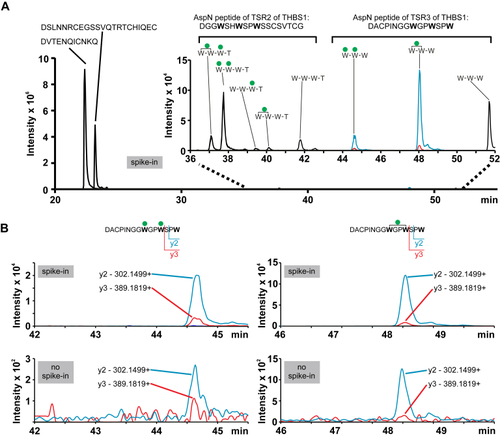Fig. 3
- ID
- ZDB-FIG-210714-3
- Publication
- Cirksena et al., 2021 - The C-mannosylome of human induced pluripotent stem cells implies a role for ADAMTS16 C-mannosylation in eye development
- Other Figures
- All Figure Page
- Back to All Figure Page
|
Endogenous THBS1 is C-mannosylated by hiPSCs.A, chromatographic separation and MRM monitoring of proteolytic peptides derived from a THBS1 fragment containing TSR1 to 3 (as shown in supplemental Fig. S2B) recombinantly expressed in HEK 293T cells. Peptides containing the consensus site for C-mannosylation (WxxW/C) with no, one, or two mannoses, elute noticeably later than the two other TSR-derived peptides and are detected at significantly lower signal intensities. B, EICs of characteristic fragment ions derived from the mono-C-mannosylated (right panels) and di-C-mannosylated (left panels) TSR3 peptide from hiPS cell culture supernatants containing recombinant THBS1 (upper panels) as a positive control (spike-in) are compared with native samples of hiPS cell culture supernatants without addition of THBS1 (lower panels). In the native samples (no spike-in), the corresponding C-mannosylated TSR3 peptides were detected with low intensities at expected elution times, confirming the presence of endogenous C-mannosylated THBS1 in hiPSC cell culture supernatants. EICs were transformed in Skyline using the Savitzky–Golay smoothing. EICs, extracted ion chromatograms; HEK, human embryonic kidney; hiPSCs, human induced pluripotent stem cells; MRM, multiple reaction monitoring; THBS1, thrombospondin 1; TSR, thrombospondin type 1 repeat. |

